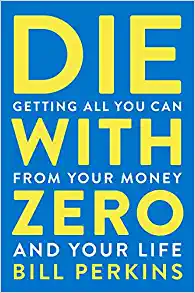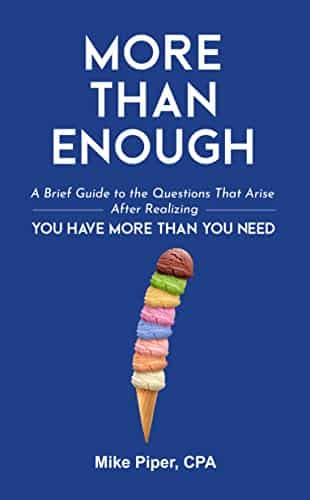Early Retirement Resources: Learning to Spend
A major focus of this blog is saving for retirement and determining when you have accumulated “enough.” Today I have a collection of resources focused on learning how to enjoy the money you have saved and use it to do more good in the world once you have enough…. or more than enough.

I’ll share a single blog post from Alan Roth and review books by Bill Perkins and Mike Piper that provide different perspectives on this important topic that so many of us who are natural savers struggle with.
I close with a podcast interview I recently recorded. Among the topics discussed were my desire to help people overcome these spending challenges that limit many of us, and how my wife and I continue to work through them.
How to Get Clients to Spend More Money
Allan Roth shares ideas that he uses to help clients who are wealthier than the average American. He admits that his research also serves the selfish purpose of helping himself overcome personal difficulty in this area. Roth writes How To Get Clients to Spend More Money.
Die With Zero
Bill Perkins’ book Die With Zero has been on my radar for awhile. I finally decided to read it after recently listening to him on a few podcast interviews and being intrigued.

I would put this book in the same category as Robert Kiyosaki’s Cashflow Quadrants. Both have many points that are technically incorrect, advice that is potentially dangerous, and writing that is at points painfully bad.
Still, each contains unique conceptual frameworks that challenge my way of thinking and seeing the world. They make each of these books worth reading with a skeptical eye, despite their limitations.
The Bad
I’ll start with the bad in Die With Zero. There was a lot I didn’t like.
Perkins’ math made me cringe. He understates the impact of compounding and oversimplifies determining your minimum financial independence number. He ignores sequence of returns risk and confuses the actuarial math of insurance companies with the inability of an individual to manage risk across a population and rely on average outcomes.
Perkins underestimates the challenges of behavioral changes when you learn to live above your means early in your life. He downplays the repeatable principles that most people can use to become millionaires and instead focuses on stories of billionaires, ignoring the combination of extraordinary luck, skill, and timing that this involves. This also makes examples in the book largely irrelevant to 99% of the population.
Die With Zero is extremely repetitive and overly simplistic, with generic advice to be more bold and less fearful, to spend more, sooner, and on experiences, and to accept the impractical idea that any money left over after you die is a “waste of life energy.” He could have cut at least a quarter of the pages without losing anything of value.
Despite the drawbacks, Die With Zero had a few principals that are so important they make the book worth reading. I’ll share the two I found most impactful.
Time Bucketing
The first is the idea of “Time Bucketing.” We’re all familiar with the idea of having a “Bucket List” of activities. These are activities that you want to do before you die.
Perkins encourages each of us to take this a step further:
- Don’t wait until you are near the end of life to make your list.
- “Bucket” your experiences into the time of life when they will be possible and most rewarding and enjoyable, and then figure out how to make those experiences happen when they most make sense to do them.
One quote particularly resonated with me. Perkins’ wrote, “Just as you can’t keep delaying ski trips because there is a minimum level of basic health you need in order to go skiing, you can’t keep delaying time with your six-year-old, because eventually your child won’t be six. Or seven. Or a child.”
This was essentially the exact thought process that led me to leave my career when I was only 41 years old and move west to pursue a radically different lifestyle. My daughter was only five years old and we were not confident we were financially independent. But we had our health, and our daughter was just reaching school age.
Our decision was not driven by hitting a mythical number on a spreadsheet and we had not mastered every aspect of our plan. Rather we made the decision because we were in a particular season of life where making this big change made sense in a way that it wouldn’t later.
I’m grateful we intuitively got this concept. It is a concept many people don’t grasp. This results in getting trapped in fear and patterns of constantly delaying gratification.
Giving Money to Kids and Charity
The other concept that resonated with me did so for the opposite reason. I wish I had better appreciated it earlier.
Perkins’ encourages us to give to our kids and charities while we are alive rather than as bequests after our death for several reasons. We can selfishly enjoy giving the gifts, have more assurance they are being used as we desire, and give them when they are likely to have maximum impact.
My parents approached me to discuss this exact topic years ago. I avoided having serious conversations about it for a number of reasons. I wanted them to spend the money they worked so hard for on themselves. My pride got in the way…. I didn’t need their help. It is painful to think about the death of those that you love.
The one big expenditure I did allow was for my parents to treat my wife, daughter, and me to a Disney cruise with them several years ago. It is a memory they were able to create and enjoy with us and which we will always treasure.
Unfortunately, my mom is currently in hospice care. If we could go back now, we would love to have more of those types of experiences and memories with her, but it is abundantly clear that phase of life is gone forever…. an opportunity missed.
I share this personal application of this concept from Die With Zero in hopes that it inspires better conversations in your lives, whether you are potentially on the giving or receiving end of the gifting of assets.
More Than Enough
Mike Piper covered this topic from a different vantage point with the new book More Than Enough. While More Than Enough covers similar topics as Die With Zero, Piper’s contribution was short on the hyperbole and long on specific actionable advice. I’ll start with a few of the stronger points of the book, and then I’ll share the one area I felt was deficient.

Finding Help
The final chapters of the book dealt with working with attorneys and financial planners, understanding when you should consider their services and how to select them. While these chapters were valuable, I most appreciated a more subtle nudge encouraging readers to seek help earlier in the book.
Piper points out in a direct, but non-judgmental way, that some natural savers’ conservatism and fear about spending money can become irrational. When this happens, it impacts quality of life. He encourages people really stuck in this position to seek the help of a mental health professional to address these fears and irrational thought patterns.
It was a powerful message, rarely shared in personal finance advice. Piper did so in an effective way by sharing his personal experience to remove the taboo many people still have around mental health issues.
Giving Purposefully
Piper points out that most people’s wills direct most or all of their assets to go to their children, if they have children, as a default position. He encourages readers to be more intentional in considering where your assets will go and when and how you will give them.
He then effectively uses the “Financial Considerations” and “Tax Strategies” portions of the books to help determine how to spend and gift more effectively both during your lifetime and after your death. Piper acknowledges the need to spend conservatively early in retirement and that this makes dying with zero unlikely and impractical.
Particularly valuable to me were discussions of tax effective giving strategies, clarity provided around which types of accounts (taxable, tax-deferred, and Roth) best meet particular spending and giving needs, and clarifying common misconceptions about impactful investing, use of donor advised funds, and deducting charitable gifts.
Living Purposefully
In the afterword, Piper elegantly summarized why all of this matters. He points out that while we may obtain more than enough money, for every one of us our time is finite. This makes time our most valuable resource. He provides a powerful reminder that the primary reason to master your money is to enable you to maximize the amount of life we can get from our limited time on earth.
This was very similar to the core message Perkins was trying to deliver in Die With Zero, but done in a much more practical, actionable, and concise way.
Omission of Social Security
In the “Financial Considerations” section, there was little consideration given to factoring Social Security benefits into the decision of whether one has enough, or more than enough. My discussions with blog readers and planning clients frequently fall into two extremes around this topic.
Some people buy into the gloom and doom talk around Social Security and prefer to plan for retirement while ignoring Social Security benefits completely, or considering them a happy bonus if they get anything. In my opinion, this benefit is too valuable to too large of a percentage of retirees to think it’s likely that it will disappear. The result of ignoring Social Security benefits is people who already likely have enough or more than enough will actually end up with way more than enough.
At the other extreme, some optimizer types justify continuing to work to get “every penny they deserve” in Social Security benefits. Due to the diminishing returns in benefits after passing Social Security bend points, this can result in a lot of effort for very little additional reward in my opinion.
I consider Piper an authority on the topic, having written the book Social Security Made Simple and developed the Open Social Security calculator. I would love to have my positions challenged or confirmed by him, so my one disappointment with the otherwise excellent More Than Enough book was the lack of consideration of this topic.
What You Need to Know About Financial Advisors
Finally, I’ll close with an interview I recorded recently for the Clipping Chains podcast: What You Need to Know About Financial Advisors. In it we discuss my motivations for getting into the financial advice industry I am such a harsh critic of and the challenges for consumers navigating conflicted advice.
We also discuss why many people do need the help of a good adviser, and how the challenge I’m most interested in working with is helping natural savers learn to spend their money and use it to live their best lives.
* * *
Valuable Resources
- The Best Retirement Calculators can help you perform detailed retirement simulations including modeling withdrawal strategies, federal and state income taxes, healthcare expenses, and more. Can I Retire Yet? partners with two of the best.
- New Retirement: Web Based High Fidelity Modeling Tool
- Pralana Gold: Microsoft Excel Based High Fidelity Modeling Tool
- Free Travel or Cash Back with credit card rewards and sign up bonuses.
- Monitor Your Investment Portfolio
- Sign up for a free Empower account to gain access to track your asset allocation, investment performance, individual account balances, net worth, cash flow, and investment expenses.
- Our Books
- Choose FI: Your Blueprint to Financial Independence
- Can I Retire Yet: How To Make the Biggest Financial Decision of the Rest of Your Life
- Retiring Sooner: How to Accelerate Your Financial Independence
* * *
[Chris Mamula used principles of traditional retirement planning, combined with creative lifestyle design, to retire from a career as a physical therapist at age 41. After poor experiences with the financial industry early in his professional life, he educated himself on investing and tax planning. After achieving financial independence, Chris began writing about wealth building, DIY investing, financial planning, early retirement, and lifestyle design at Can I Retire Yet? He is also the primary author of the book Choose FI: Your Blueprint to Financial Independence. Chris also does financial planning with individuals and couples at Abundo Wealth, a low-cost, advice-only financial planning firm with the mission of making quality financial advice available to populations for whom it was previously inaccessible. Chris has been featured on MarketWatch, Morningstar, U.S. News & World Report, and Business Insider. He has spoken at events including the Bogleheads and the American Institute of Certified Public Accountants annual conferences. Blog inquiries can be sent to chris@caniretireyet.com. Financial planning inquiries can be sent to chris@abundowealth.com]
* * *
Disclosure: Can I Retire Yet? has partnered with CardRatings for our coverage of credit card products. Can I Retire Yet? and CardRatings may receive a commission from card issuers. Some or all of the card offers that appear on the website are from advertisers. Compensation may impact on how and where card products appear on the site. The site does not include all card companies or all available card offers. Other links on this site, like the Amazon, NewRetirement, Pralana, and Personal Capital links are also affiliate links. As an affiliate we earn from qualifying purchases. If you click on one of these links and buy from the affiliated company, then we receive some compensation. The income helps to keep this blog going. Affiliate links do not increase your cost, and we only use them for products or services that we're familiar with and that we feel may deliver value to you. By contrast, we have limited control over most of the display ads on this site. Though we do attempt to block objectionable content. Buyer beware.
Coincidentally I recently read both of the books you reviewed and completely agree with your evaluation of them. In fact, I think readers could skip Die With Zero because you made the two most valid points. In regards to Mike Piper’s book, although you summarize the most important points well, I think readers could get still more value from reading the book. I hadn’t thought of the point you made about his omission of a discussion of the role of Social Security (maybe because I had already read his book and used his calculator); it’s well-taken.
I also enjoyed the Alan Roth article; lots of great food for thought there.
I’m sorry to hear that your mother is in hospice. Having been there with loved ones too many times, I appreciated what hospice gave us—relief from physical pain for the loved one, and the chance to have important conversations. I hope you have the same experience.
Thanks for another thoughtful blog post.
Thanks for taking the time to leave such a thoughtful comment Elizabeth.
Best,
Chris
Chris
An excellent post. I was especially moved by the Disney story. My wife and I are 67 and almost 65 and so far in good health but things can go south quickly. We love to travel and realize it could be over just like that if one of us becomes ill. We have also become much more generous as we have realized we have more than enough.
All the best to your family, we have been there and it is a very tough season.
Regards
Mark
Thanks for the kind words Mark.
I read Die with Zero and my reaction was similar to yours. There were a couple good bits of advice. I especially liked the concept of a “Memory Dividend” and have been thinking about ways to prioritize spending my time on experiences that I can’t have later. I agree with you that the rest of the book is full of advice that doesn’t apply to the vast majority of people, and is potentially dangerously wrong. It seems especially hard for a married couple to “self insure” and spend down all their money to zero in the way he suggests, since one spouse is likely to outlive the other.
I added More than Enough to my reading list, thanks for the recommendation.
Thanks for the feedback Liz. I hope you find More Than Enough as useful as I did.
Best,
Chris